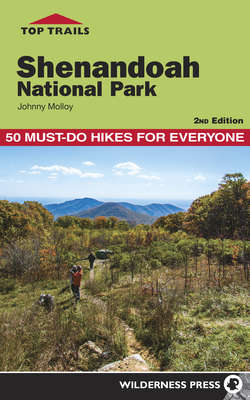Читать книгу Top Trails: Shenandoah National Park - Johnny Molloy - Страница 14
Camping
ОглавлениеDeveloped (frontcountry) camping is available at the park’s five official campgrounds. See nps.gov/shen/planyourvisit/campgrounds.htm for details. Stay limits are 14 consecutive nights in season and 30 consecutive nights in the off-season.
Backpackers must obtain a free backcountry permit to camp overnight in the wilds of Shenandoah. Permits can be obtained at the following places during business hours, starting at the north end of the park:
Front Royal Entrance Station, milepost 0.6 on Skyline Drive
Dickey Ridge Visitor Center, milepost 4.6 on Skyline Drive
Panorama, milepost 31.6 on Skyline Drive
Old Rag Fee Station, off Nethers Road/VA 600 on the eastern edge of the park (GPS: N38° 34.297' W78° 17.346')
Big Meadows, milepost 51.2 on Skyline Drive
Swift Run Gap Entrance Station, milepost 65.7 on Skyline Drive
Loft Mountain Information Station, milepost 79.5 on Skyline Drive
Rockfish Gap Entrance Station, milepost 104.9 on Skyline Drive
Permits for Appalachian Trail long-distance hikers are available by self-registration on the AT where it enters Shenandoah National Park from both the north and the south.
You can also obtain a backcountry camping permit by mail when you plan your trip at least two weeks in advance by contacting park headquarters at 540-999-3500. Bring two filled-out copies of your permit, and deposit one copy in the self-registration box at each entrance station. The other copy should be affixed to your pack or tent in full view when in the backcountry.
Backcountry Camping Regulations
1. You must have a free backcountry camping permit (see previous page).
2. Food, trash, and scented items must be stored in a tree at least 10 feet above the ground and 4 feet out from a tree trunk, within a park-approved bear-resistant food storage canister, or from a food storage pole provided at backcountry huts on the AT.
3. Backcountry campfires are not permitted.
4. A few specific areas in the park are completely closed to backcountry camping: Old Rag Mountain above 2,800 feet, most of Little Stony Man Mountain, Hawksbill above 3,600 feet, Mary’s Rock summit, North Mount Marshall summit area, a portion of Whiteoak Canyon, and around Overall Run Falls. Other areas where backcountry camping is prohibited include the clearings of Big Meadows and within 0.5 mile of Camp Rapidan. If you’re planning a hiking trip and/or a backcountry overnight trip to one of those areas, check the park’s website for precise maps of closed areas: nps.gov/shen/planyourvisit/campbc_regs.htm.
5. Look for a legal, comfortable, and safe place to camp: one that protects the park as well as the solitude of other hikers and campers. A common strategy is to choose a preexisting campsite—that is, a site that was created and established by previous visitors and is not posted, signed, or officially designated by the park. Look for a preexisting site at least 20 yards from a trail or an unpaved fire road.
If you can’t locate a preexisting campsite, you may camp on a previously undisturbed area. Limit your stay to one night; camp well out of sight of trails, roads, and other camping groups; and practice Leave No Trace principles (see lnt.org for more information):
• Properly dispose of human waste.
• Limit maximum group size to 10 individuals.
• Pack out all trash and dispose of it properly.
Another backcountry option is a hut or cabin maintained by the Potomac Appalachian Trail Club (PATC) inside the park. Huts are three-sided structures located along the AT and are intended for use by hikers who are on the trail for three consecutive nights or more. Backcountry camping permits are required for camping in huts, and all Shenandoah backcountry camping regulations apply. Permits aren’t required for cabins, which must be reserved in advance with the PATC (call 703-242-0315, ext. 102, or visit patc.net for more information).
A fourth option for AT hikers is a designated campsite: a park-constructed site that provides overflow camping space near an occupied AT hut. Designated campsites are marked with a post bearing a tent symbol.
6. No camping may occur (a) within 10 yards of a stream or other natural water source; (b) within 50 yards of standing building ruins including stone foundations, chimneys, and log walls; (c) within 50 yards of another camping party or a NO CAMPING post or sign; (d) within 0.25 mile of a paved road, park boundary, or park facilities such as a campground, picnic area, visitor center, lodge, wayside, or restaurant; or (e) within 100 yards of a hut, cabin, or day-use shelter, except at designated campsites as described above.
7. Pets must be leashed at all times and are prohibited altogether on some hiking trails. Hikes where pets are not allowed are indicated throughout the book.
8. Campers may not exceed 2 consecutive nights in one location or 14 consecutive nights total in the backcountry.
